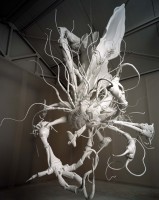LEE BUL
イ・ブル
source: ideafixa
Lee Bul é uma artista coreana, que faz essas esculturas e instalações incríveis, com espelhos, cristais, resina e qualquer outro material que se possa imaginar.
Ela discute a relação do humano com a tecnologia e a cultura pop: a vontade do homem de ter super-poderes e buscar a perfeição da forma desde sempre, seja por cirurgia plástica, atachando chips ou qualquer outra forma digital no corpo e em tudo que constrói.
O resultado são formas meio humanas/meio robóticas/meio monstruosas, sempre muito bonitas e complexas, que dão uma idéia de possibildiades da bio-tecnologia e arquitetura pro nosso “so called” future.
.
.
.
.
.
.
.
source: lehmannmaupin
Lee Bul (b. 1964, Korea) grew up in Seoul and received a BFA in sculpture from Hongik University. Considered the leading Korean artist of her generation, she has achieved international renown for her formally inventive, intellectually provocative oeuvre. Demonstrating virtuosity across diverse media – from drawing and performance to sculpture, painting, installation, and video – her multifaceted production is representative of the most innovative aesthetic currents shaping contemporary art in the global sphere.
Lee Bul’s work has been featured in solo presentations at museums throughout the world, including the Museum of Modern Art, New York (1997); Kunsthalle Bern, Switzerland (1999); Fabric Workshop and Museum, Philadelphia (2001); MAC, Musée d’Art Contemporain, Marseille (2002); the New Museum of Contemporary Art, New York (2002); Le Consortium, Dijon (2002); Japan Foundation, Tokyo (2003); the Power Plant, Toronto (2003); Museum of Contemporary Art, Sydney (2004); Domus Artium, Salamanca (2007); and Fondation Cartier pour l’art contemporain, Paris (2007 – 2008), and most recently, the Mori Art Museum in Tokyo, Japan (2012). She has also participated in important group exhibitions around the world, and in 1999, she was awarded a prize at the 48th Venice Biennale for her contribution to both the Korean Pavilion and the international exhibition in the Arsenale curated by Harald Szeemann. The artist currently lives and works in Seoul, Korea.
.
.
.
.
.
.
.
source: fireplacechatswordpress
“Starting out in the late 1980s, Korean artist Lee has witnessed some big changes within the global art scene. She was one of the first women artists from Asia to exhibit in major international art museums during the Asian art boom of the ’90s — a time when many Asian art biennales were being launched, and exhibitions focusing on Asian artists were still quite rare in Western art museums.”
“In the 1990s, the label ‘Asian Woman Artist’ was a term that caused me a lot of grief, actually,” says Lee at an interview during her recent visit to Tokyo for an artist talk.”
“Despite her upbringing in a very political family, Lee has never personally identified with South Korea’s late-coming feminist movement. “I don’t believe in any ‘isms’ ” she says. But she is an artist who constantly questions political ideals. Specifically, she questions what she sees as civilization’s chronic belief in utopianism.”
“Lee Bul seems to be famous for all the wrong reasons. The major Korean contemporary artist, who has a retrospective at the Mori Art Museum, had her first big break in 1997 at the Museum of Modern Art in New York, when an artwork she was exhibiting, containing dead fish, literally started stinking and forced the exhibition to be shut down. The controversy this caused led her to get noticed by the wider art world. Yes, once again, as with Andres Serrano’s Piss Christ, Chris Ofili’s elephant dung paintings, or Damian Hirst’s pickled animals, a contemporary artist gained fame by doing something repulsive to normal people.”
“Lee Bul address the dualism between a highly traditional society and tremendous technological advances.”
“Lee Bul explores through her pieces trends in popular culture, themes of feminine identity, and representation of femininity interpreted in a science fiction fantasy key, such as her “Cyborgs” pieces, a series of coloured smooth silicone sexualised armours with female shapes but with several limbs.” missing, aimed at analysing the relationship between woman and machine.”
“Lee’s artworks seemingly display a fascination with dichotomies such as art and bioengineering, utopia and dystopia, virtual reality and investigations of contemporary forms of popular entertainment.”
.
.
.
.
.
.
source: public-image
1964年生まれ、ソウル市在住。弘益(ホンイク)大学で彫刻を専攻。1990年代後半には国際的にも高い評価を受け、グローバル化以降のアートシーンの中でアジアを代表するアーティストとしての位置を確立した。ニューヨーク近代美術館(1997年)、ル・コンソルシウム(ディジョン、2002年)、国際交流基金フォーラム(東京、2003年)、カルティエ現代美術財団(パリ、2007-2008年)などで個展のほか、欧米、アジアを中心にグループ展多数。1998年にはヒューゴ・ボス賞ファイナリスト。1999年の第48回ヴェネチア・ビエンナーレでも受賞歴がある。
.
.
.
.
.
.
source: graficacolectivaorg
la obra de la artista coreana lee bul se caracteriza por situarse dentro del ciberfeminismo y sus planteamientos —identidad, teratología o post-humanismo—. desde los años 90, primero con la performance y más tarde con piezas escultóricas, instalaciones y vídeo, bul se ha convertido en una de las artistas más interesantes del panorama actual. sus obras simulan la dicotomía que sentimos frente a la tecnología —y las promesas incumplidas en torno a ella—, las envolturas de sus esculturas brillantes atraen al espectador, pero al mismo tiempo repelen por sus formas sinuosas que recuerdan a las criaturas creadas por giger.


